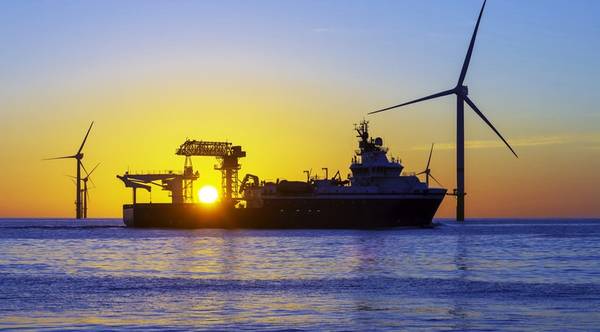
While many challenges remain to deliver the full promise of U.S. offshore wind, so too do opportunities. Robert Galinski, DNV’s Offshore Wind Director, Americas discusses the pace and direction of the U.S. offshore wind market from the perspective of class.
While Robert Galinski has served as DNV’s Offshore Wind Director, Americas, for just about one year, he is well-versed and long-tenured in the offshore wind sector in Europe and the U.S. for more than a decade, starting his career in offshore wind managing the fabrication, assembly and installation offshore wind farms on the west coast of the UK and Belgium. Relocated to Houston in 2019, today Galinski is responsible for the management of operations and strategy related to DNV's classification business for offshore developments in the Americas.
After numerous stops and start, the wind business in North America is finally picking up steam, with the political will established and funding starting to flow to meet the Biden Administration’s 30/30 mandate – 30 GW of offshore wind power by 2030.
“The 30 by '30 target has really put the offshore wind on the map in the U.S.,” said Galinski, in his recent interview with Maritime Reporter TV. “The potential for development of clean energy using offshore wind was known for some time, but there was always – and there still remains in some circles – this reluctance to how cost effective this can be. The commitment we see from the federal government is encouraging.”
While there remain numerous hurdles to jump before offshore wind is running at speed in the U.S., Galinski maintains that there is strength in numbers. “By mid-2020s, we'll see multiple commercial-scale projects coming online,” he said. “We must ensure that we leverage the experience from existing projects (both existing domestic) and other parts of the world, especially in Europe, to avoid delays and negative financial impact. It's up to the supply chain to react as a collective to ensure that the 30 by '30 targets are met, and it's encouraging to see this happening already at a good pace.”
“Building a strong renewable industry for the future will be only successful once we create a strong supply chain locally,” said Galinski. “Leveraging experiences from outside (the U.S.) is important, but we can't forget that we have a pioneering workforce in the U.S. that triumphed in the oil and gas industry and continues to excel in that segment. So being open to global experiences while using local expertise is a very powerful mix and a winning formula to do in 7 to 8 years, what it took Europe 20 to do.”
DNV has been involved in offshore wind since it became a scalable concept in the 1980s, and according to Galinski the organization has been involved in the vast majority – 97% – of world's offshore wind projects. “This gives us an edge when it comes to global understanding of challenges related to design, fabrication, construction, installation, and operation of these turbines,” he said.
Added to the offshore wind experience is more than 150 years of regulatory experience across multiple industries, from maritime, oil & gas to healthcare and food. “If we narrow it down to exposure in just offshore wind, I can tell you that we have more than 2,000 energy experts” in house, said Galinski.
 “Building a strong renewable industry for the future will be only successful once we create a strong supply chain locally. Leveraging experiences from outside (the U.S.) is important, but we can't forget that we have a pioneering workforce in the U.S. that triumphed in the oil and gas industry and continues to excel in that segment. So being open to global experiences while using local expertise is a very powerful mix and a winning formula to do in 7 to 8 years, what it took Europe 20 to do.” -- Robert Galinski, DNV’s Offshore Wind Director, Americas
“Building a strong renewable industry for the future will be only successful once we create a strong supply chain locally. Leveraging experiences from outside (the U.S.) is important, but we can't forget that we have a pioneering workforce in the U.S. that triumphed in the oil and gas industry and continues to excel in that segment. So being open to global experiences while using local expertise is a very powerful mix and a winning formula to do in 7 to 8 years, what it took Europe 20 to do.” -- Robert Galinski, DNV’s Offshore Wind Director, Americas
Building the Fleet
When assessing the many challenges ahead, invariably the availability of vessels and shipbuilding capacity come to the fore, as the offshore wind sector is seen primarily as a newbuild versus retrofit market. The cost to build vessels in the U.S. compared to the Far East, plus the rapid inflation of base product such as steel – not to mention the year’s-long supply chain snarls – have all conspired to make vessel construction more challenging and expensive.
“We must not lose momentum to ensure projects don't suffer in delays,” said Galinski. “Foreign flag vessels may be used in short-term, like they have been on Block Island for ease of transition. Foreign vessels, WTIVs in particular, in combination with the Jones Act feeder vessels, like those being offered by some of the designers now, are a proven alternative. For this combination, however, to continue to be viable, the cost of construction and complexity of the Jones Act feeder needs to be controlled.”
As the projections for U.S. offshore wind become a reality, the shipbuilding and ship supply base should be energized to produce a variety of boats and ships, from CTVs to SOVs to WTIVs and everything in between.
“Global SOV numbers in the next 10 to 15 years will be more than 60 vessels,” said Galinski, “and I think the U.S. will probably take just under a third of that, if all of the projects in the pipeline are realized,” noting that CTV and SOV newbuild capability is high in the U.S. The real challenge will come with the design, construction and delivery of the larger and more complete Wind Turbine Installation Vessels (WTIV), particularly in the face of ever-larger turbines, expected soon to pass the 15MW per unit mark.
“I estimate between four and six Jones Act installation vessels will need to be built in the U.S. to the end of the decade,” said Galinski.
While newbuild vessels will, in the long run, be the preferred choice premised on their efficiencies as well as the ability to design in fuel flexibility for future changes, Galinski said he expects existing vessels in the U.S. fleet to play a role in the short term.
“Given what we've discussed, there needs to be some space for existing vessels and they can certainly fill some gaps; but only up to a point. Many of the existing U.S. OSVs, for example, could support both the commissioning and the operational phase. Most likely they'll need to be retrofitted with walk-to-work systems and extra accommodation. This can be a way of getting more of the larger PSV fleets operational in shorter time, an alternative of building new tonnage,” he said.
While retrofitting existing ships will plug some holes, “there will come a point where they won't be cost efficient, and it would make more sense to build a tailor-made new build, particularly for SOVs.”
He estimates time window to use converted vessels at two and five years, with the long-term eye on bespoke designed tonnage that are outfitted and optimized for the task at hand, outfitted too with low emission technologies and effective energy saving systems, like battery hybrids.